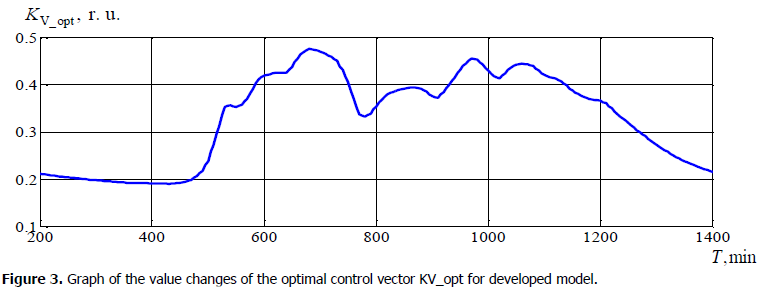Research Article - (2020) Volume 10, Issue 2
Abstract
A system of automated control for local air recuperation was synthesized for the securement of the optimal microclimate parameters in the accommodations of the educational institutions for children. A computer imitational modelling of the system of automated control for local indoor air recuperation by parameters of temperature and СО2 concentration. The advantages of the proposed system have been proved, which allowed reducing the duration of the zone with exceeding the maximum permissible level of CO2 concentration by 49.5% and reducing the value of CO2 concentration by 13.1%, provided that the temperature is kept within the maximum permissible limits.
Keywords
System of local air recuperation; indoor microclimate; system of automated control; air temperature; air quality
Introduction
The provision of a comfortable air-thermal regime of study rooms is one of the important factors affecting the studying effectivity and health of both school children and teachers. Deviations of the air temperature normative values in the rooms in combination with high humidity influences the intensification of the heat transfer processes, which leads to the cooling of the body and as a consequence - the development of diseases. In addition, the physicochemical composition of the air environment constantly varies throughout the day due to the release of products of life of people in the indoor air: the ionic composition of the air changes, the number of heavy particles increases. This causes a deterioration in performance (the appearance of lethargy, headache, loss of concentration) and health (increase in heart rate, changes in blood pressure, irritation of the mucous membranes, cough, etc.) both students and teachers (Sukach, 2016).
Literature data analysis and problem statement
State policy aimed at meeting the requirements of the Law of Ukraine “On Energy efficiency of buildings” which encourages the intensification of energy saving mechanisms during the construction of new and reconstruction of existing school buildings. The basic principles of thermal-modernization are to increase the thermal resistance of the enclosing structures of buildings, which significantly increases their density and accordingly minimizes natural air infiltration. Cross-ventilation of the accommodations over a 5-10-minute break reduces the content of carbon dioxide (CO2) by 33-50%, but this concentration does not meet the recommended values of 1000 ppm (DBN, 2013). The situation is further complicated by the increase in the concentration of carbon dioxide in the ambient air. Such deterioration of the ecology condition is caused by active negative influence of a humanity, in particular, permanent burning of fossil fuel, deforestation of large tracts of forests, increase of production capacities of enterprises, growth of the number of cars, etc. , (Waheed, 2019). The data of experimental studies of the parameters of thermal comfort have confirmed (Ivasenko, 2018), that in most children's educational institutions the ventilation systems are idle or absent at all, and the normative indicators of the microclimate of the premises do not meet the normative (DBN, 2013). Restoration of centralized ventilation systems is complicated by the partial dismantling of systems of inflow and exhaust installations, their low efficiency, the integrity of inflow and exhaust ducts and the inability to meet the requirements of indoor air exchange (DBN, 2012; DBN, 2018). Local ventilation units are often used to ensure a minimum allowable level of thermal comfort. However, existing local recuperative ventilation units, while improving the indoor climate, have a number of disadvantages, such as the increase of noise background, the presence of cold drafts in their installation areas, etc., which makes it impossible to use them in educational institutions for children. The issue of ensuring the optimal microclimate of the accommodations of educational institutions is considered in (Cao, et al., 2014; Lei, 2017; Cheng, 2016; Panaras, 2018; He, 2014), but in most cases attention is paid to ventilation systems energy-saving modes of operation (Cao, et al., 2014; Lei, 2017), or the development of ventilation systems with natural drift (Cheng, 2016) which may not always provide a calculated air exchange in winter season. The potential of natural ventilation to provide quality air composition in the premises of US educational institutions during the periodic operation of mechanical ventilation systems is considered in (Panaras, 2018). The problems of providing the necessary conditions of thermal comfort and acceptable air quality for educational institutions through simulation modelling in the COMIS environment were investigated in (He, 2014) and the necessity of forced ventilation was proved. The study of the microclimate of the dormitories of a university in one of the largest cities in central China is devoted to work (Avramenko, 2012). At the same time, although the works of state the fact of such a problem, no single effective solution is proposed. To development of the autonomous control systems (ACS) of local air recuperation are devoted a number of works, in particular (Vasiliev, 2016) developed a mathematical model of the ventilation complex with regard to the coefficient of comfort, which depends on two microclimate parameters: the temperature and relative humidity, but the air environment qualitative composition indices were not taken into account. In Pleshkov, 2018 an algorithm for automation of supply and exhaust ventilation of rooms with variable air flow, as well as the harmful emissions generated during mechanical processing of composite polymeric materials, was developed. However, the synthesized system of quantitative regulation of the supply air takes into account only the indicator of carbon dioxide, which allows to provide the necessary parameters of the air quality in the room, the not less important parameter of the microclimate - the temperature of the room is not taken into account. Therefore, further exploration of the possibilities of creating a comfortable and safe air environment of the study premises is a priority of the health and ecology system.
The purpose and objectives of the study
The goal of article is to develop an automatic system of local air recuperation to provide thermal comfort and normative composition of the air environment of the accommodations of children's educational institutions. To achieve this goal, the following tasks were set: - to develop the algorithm for determining the control vector and the structural diagram of the ACS microclimate of the room; - create a computer simulation model of microclimate control using ACS containing control channels for temperature and concentration of carbon dioxide; - to determine the effect of using a developed algorithm for automatic control of local recovery installations by computer simulation.
Materials and Methods
The parameters of the microclimate include: air temperature, relative humidity of the premises, air velocity, intensity of thermal radiation and surface temperature. Hygienic regulation of the microclimate of the premises is determined depending on the age of the child, the functional purpose of the room and climate zone. The boundaries of the permissible zones in the premises of children's educational institutions are air with a relative humidity (20...70)% with temperature t (16...24)°С and content of СО2 (1000...1500) ppm. One of the ways to increase the efficiency of the local air recuperation system, namely to maintain the normative requirements for thermal comfort and the normative composition of the air of the accommodations of children's educational institutions is to create optimal microclimate parameters by improving the systems of automatic control of local recuperation devices. On Figure 1 shown the generalized structural scheme of the system of automated control of the indoor microclimate in children educational institutions with facilities of local air recuperation. On Figure 1: tatm, Сatm – the values of temperature and carbon dioxide concentration for air, which given as, as a perturbation to the object; t’atm , С’atm, t’ins, С’вн – measured values of temperature and carbon dioxide concentration for inner and outer air; Кopt – vector of optimal values, which was determined by system of automated control, Wopt – vector of control influences on local recuperation system productivity(object of control).
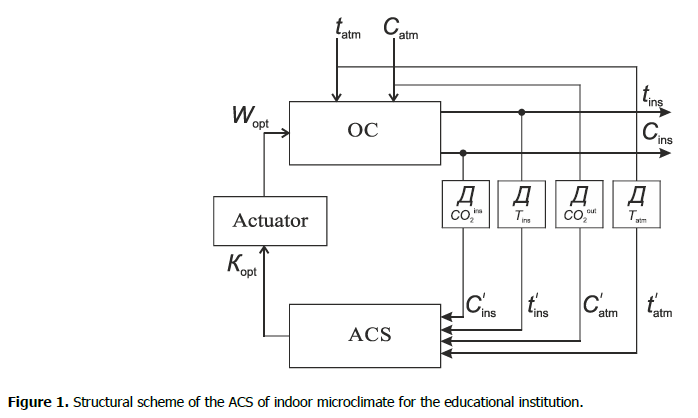
Figure 1. Structural scheme of the ACS of indoor microclimate for the educational institution.
The indoor climate model of the facility consists of two independent channels – temperature and concentration of carbon dioxide. For the temperature control channel, the dependence of the indoor temperature in the room tins on the outside air temperature and the air mass exchange in the room is from the balance of thermal power:

where Qr – indoor heat energy, Wt; Qs – heat energy, which supplied from inner sources (heating equipment, humans), Wt; Qout – thermal energy consumed with the outgoing air; Qinc – thermal energy supplied to the room with the incoming air. Balance of thermal power in differential form:

where – time, s; mair – the mass of air in the room, kg; сair – specific heat capacity of air, Wt/kg·ºС; mout –the mass of exhaust, air kg; minc – the mass of supplied air, kg; tins – temperature indoors, ºС; tatm – temperature of supplied air,ºС. Then perform algebraic transformations of equation (1), assuming, that mout = mins = mvent:


Then find the general solution of the problem in the form of a first-order aperiodic function:

Then, general equation solution (3) has next form:

For the founding of partial solution of the equation (2) accept initial conditions for = 0; t = tins an equation (5) will become:
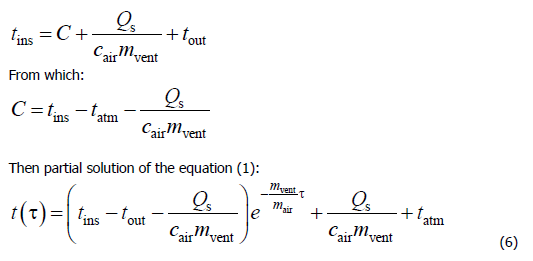
After conducting some algebraic transformations, we get finite partial solving of the equation (2):

where Кv – multiplicity of air cycling indoors, determined:

where air – air density, kg/m3; Vvent – air volume, which was supplied to the room by at the expense of the work of the local recuperation system, m3; V air – air volume, which consisted in the educational room, m3. In a similar way then determined an equation for the carbon dioxide concentration for educational accommodation. Solving of the equation for balance of carbon dioxide concentration for educational accommodation:

where n – number of students in this accommodation; Ср – amount of carbon dioxide, which supplied to indoor air from children, mg. In dependence from current interaction between the temperature Тvn and carbon dioxide concentration Сvn in the air of the room can be distinguished two modes of operation: 1. Indoor temperature control regime. Subject to non-compliance level of minimal permissible carbon dioxide concentration (Сvn – Сvn_norm) 1500 ppm, the temperature indoors maintained on the normal level. 2. Carbon dioxide control regime. Provided that the room temperature is temporarily reduced below the regulatory value (Tvn – Tvn_norm) 4ºС, maintained the level of the minimum permissible concentration of carbon dioxide. Automatic air flow control must be provided to reduce thermal comfort and maintain a minimum concentration of carbon dioxide facilities of local recuperation. For takin into account of such influence the task of managing facilities of local recuperation, taking into account the comfort level and the normative composition of the indoor air environment, is most expediently interpreted as a multicriteria optimization problem (Zinzura, 2012). The formulation of such a problem has the next form:
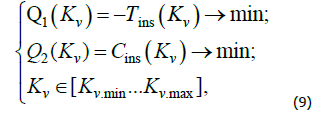
where Q1, Q2 – optimisation criteria; Kv – multiplicity of air recirculation indoors at expense work of the local recuperators; [Kv min… Kv max] – the zone of permissible values of multiplicity of air cycles Kv; Тins(Kv) – value of stable deviation of inner temperature indoors at the expense of supplied air from facilities of local recuperation:

where tins – indoor temperature; tout – outer temperature of the heat flow, which was supplied by facilities of local recuperation.

Where Сins(Kv) – value of the stable deviation of carbon dioxide concentration in the air indoors; Сins – current value of carbon dioxide concentration in the indoor air; Сout – current value of carbon dioxide concentration in outer air. The solution of the problem of multicriteria optimization of appearance (9) is obtained by applying the method of approximation to a utopian point in the criterion space. With a goal of study of the interaction of parameters on the microclimate of the institution was developed by ACS performance of plants local recuperation in rooms of the children educational institutions. Modelling of inner temperature and carbon dioxide change dynamic that occur during system operation local recuperation, realised by the computer imitational modelling. Generalized structural scheme of given computer imitational model of the ACS shown on Figure 2. On Figure 2: «The thermal model of accommodation» – high temperature simulation unit and indoor carbon dioxide concentration; «ACS ventilation system» is a unit of simulation work for facilities of local recuperation. The temperature and concentration of carbon dioxide in the ambient air, as well as the actual results of daily measurements of the microclimate of a kindergarten in Kropyvnytskyi, were used as input to the simulation. For the basic model comparison, the model ACS is selected, which performs such control of the level of thermal comfort, in which the deviation of the temperature ΔТвн in the room does not exceed the normal allowable value 4°С, a deviation of carbon dioxide concentration indoors is not normalized. The computer simulation of the indoor climate at the expense of ACS local exhaust ventilation was as follows. For each model input, the optimal control vector and mode parameters are determined for two cases: - the formation of optimal conditions of thermal comfort without controlling the concentration of carbon dioxide in the room air; - formation of normative value of thermal comfort and concentration of carbon dioxide in the room air.
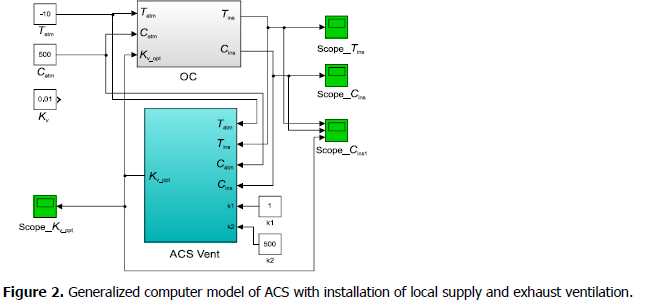
Figure 2. Generalized computer model of ACS with installation of local supply and exhaust ventilation.
Results of computer imitation modelling was shown on Figures 3 – 5 in schedule form.
Figure 3. Graph of the value changes of the optimal control vector KV_opt for developed model.
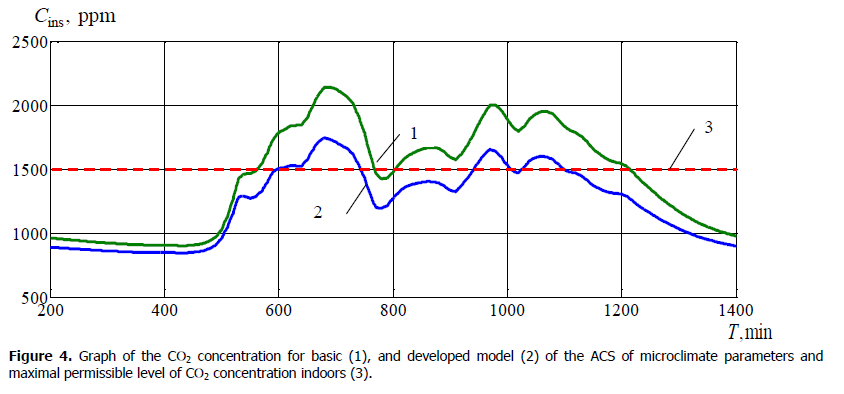
Figure 4.Graph of the СО2 concentration for basic (1), and developed model (2) of the ACS of microclimate parameters and maximal permissible level of СО2 concentration indoors (3).
As shown on Figure 4, duration of the zone with the excessing of maximal permissible concentration level of СО2 indoors in case of the proposed in the article model appeared on 49,5 % (567 min) less, than for basic model. In addition, as can be seen from Figure 5 developed system also limits the temperature deviation in the room, which allows to maintain acceptable values of thermal comfort according to requirements (DNB, 2013).
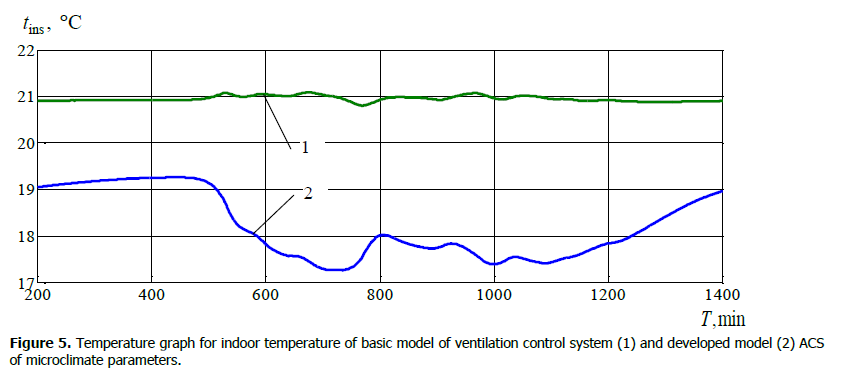
Figure 5.Temperature graph for indoor temperature of basic model of ventilation control system (1) and developed model (2) ACS of microclimate parameters.
Based on the simulation results, a statistical analysis of the simulation results for the base and developed model was performed, which results were shown in the table 1.
| № | Microclimate parameters | Mathematical expectation, М | The standard deviation, |
|---|---|---|---|
| Basic model of ventilation control system | |||
| 1 | tins | 20,9 | 0,059 |
| 2 | ССО2 | 1451,41 | 230,63 |
| Developed model of ventilation control system | |||
| 1 | tins | 18,1 | 0,385 |
| 2 | ССО2 | 1261,36 | 161,19 |
Table 1. Results of statistical analysis for modelling variants.
Statistical processing of the results of the modelling of microclimate parameters in the accommodations of the educational institution (table. 1) showed that the developed model allows to reduce the level of concentration of carbon dioxide by 13,1% in comparison with the basic model, provided that the temperature is kept within the maximum permissible limits.
Conclusion
1. An analysis of literature sources confirmed the absence of systems for automatic control of local air recuperation to secure optimal parameters of the microclimate of accommodations children's educational institutions, which taking into account the temperature and concentration of CO2. Therefore, further searching for opportunities to create a comfortable and safe indoor air environment is a priority. 2. As a result of the conducted researches founded that the task of managing local recuperation installations, taking into account the level of comfort and normative composition of the indoor air environment, is most expedient to be interpreted as a problem of multicriteria optimization, and its solution can be obtained using the method of approaching a utopian point in the space of criteria. 3. The analysis of the effect of the proposed approach confirmed the advantages of the proposed system by reducing the duration of the zone with exceeding the maximum permissible level of CO2 concentration by 49.5% and reducing the value of CO2 concentration by 13.1%, while maintaining the temperature within the maximum permissible limits.
References
Sukach, S.V. (2016). Assessing the Impact of the Microclimate of the Study Rooms on the Mental Performance of Students. SV Sukach, T. F. Kozlovskaya. Problems of Labor Protection in Ukraine. 31: 105-112.
DBN B.2.5-67: (2013) "Heating, ventilation and air-conditioning". Ministry of Regional Development of Ukraine, 141 p.
Waheed, A. (2019). The Impact of Renewable Energy on Carbon Dioxide Emissions: An Empirical Analysis of Selected South Asian Countries/ A. Waheed, M. Tariq. Ukrainian Journal of Ecology, 9(4) 527-534.
Ivasenko, V. M. (2018). Measurement of carbon dioxide in public, residential and office buildings / V.M. Ivasenko, B.S. Ganchev // Scientific Journal "ScienceRise". 48: 38-41.
DBN B.2.5-64 (2012). Internal water supply and sewerage. Part I. Designing. Part II. Construction. Change # 1.
DBN B.2.2-3 (2018). Buildings and Structures. Educational institutions. Cao, G., Awbi, H., Yao, R., Fan, Y., Sirén, K., et al. (2014). A review of the performance of different ventilation and airflow distribution systems in buildings. Building and Environment. 73: 171–186. Chenari, B., Dias, Carrilho, J., Gameiro, da., Silva, M. (2016). Towards sustainable, energy-efficient and healthy ventilation strategies in buildings: A review. Renewable and Sustainable Energy Reviews. 2016. Vol. 59. P. 1426–1447. doi: https://doi.org/10.1016/j.rser.2016.01.074.
Lei, Z., Liu, C., Wang, L., Li, N. (2017). Effect of natural ventilation on indoor air quality and thermal comfort in dormitory during winter / Building and Environment. 125. P. 240–247. doi: https://doi.org/10.1016/j.buildenv.2017.08.051
Cheng Z., Li L., Bahnfleth, W. P. (2016). Natural ventilation potential for gymnasia – Case study of ventilation and comfort in a multisport facility in northeastern United States. Building and Environment. 108. P. 85–98. doi: https://doi.org/10.1016/j.buildenv.2016.08.019.
Panaras, G., Markogiannaki, M., Tolis, E. I., Sakellaris, Y., Bartzis, J. G. (2018). Experimental and theoretical investigation of air exchange rate of an indoor aquatic center. Sustainable Cities and Society. 39. P. 126–134.
He, M., Zheng, J., Liu, Z. (2014). Study on indoor thermal environment under winter air-conditioning condition in one university students' dormitory in Chongqing. Refrigeration and Air-conditioning. 14, 89–93.
Avramenko, M. M., Avramenko, M. M., Sukach, S. V., Kobyliansky, M. A. (2012). Support for microclimate parameters in regulatory limits as a means of creating comfortable working conditions, Electromechanical and energy-saving systems: a quarterly research and production journal. Kremenchuk: KNU, P. 94–99.
Vasiliev, K. A. (2016). Modeling of an air conditioning system in the areas of machining of composite materials of shipbuilding production / K.A. Vasiliev. Bulletin of the State University of the Sea and River Fleet. S.O. Makarova. No. 6 (40) 129-139.
Pleshkov, P. G., Garasyova, N. Yu., Soldatenko, V. P. (2018). Optimal control of the mode of operation of the combined electricity system with renewable energy sources, Bulletin of the National Technical University "KPI". Series: Problems of Improving Electrical Machines and Appliances. Theory and Practice - Kharkiv: NTU "KPI", №32 (1308), P. 64-70.
Zinzura, V. V. (2012). Methods for solving the problem of multicriteria optimization of voltage regulation in electrical networks Collection of scientific papers of Kirovograd National Technical University. Engineering in agricultural production, branch engineering, automation. 25, Part 1 - Kirovograd: KNTU, 350-360.
Author Info
P.H. Plieshkov, K.H. Petrova, I.V. Savelenko*, O.I. Sirikov and N.Yu. HarasovaCitation: Plieshkov, P.H., Petrova, K.H., Savelenko, I.V., Sirikov, O.I., Harasova N.Yu. (2020). Securement of the optimal microclimate parameters in accomodations of the educational institutions for children by implementation of the system of local air recuperation. Ukrainian Journal of Ecology, 10 (2), 1-7.
Received: 27-Feb-2020 Published: 29-May-2020, DOI: 10.15421/2020_55
Copyright: This is an open access article distributed under the terms of the Creative Commons Attribution License, which permits unrestricted use, distribution, and reproduction in any medium, provided the original work is properly cited.

